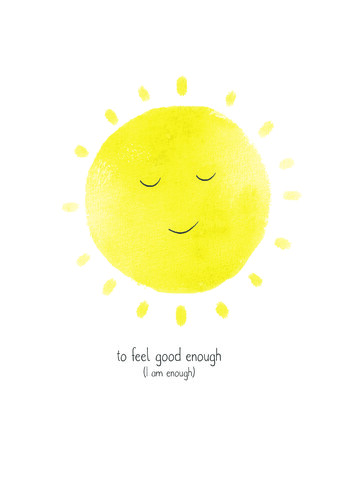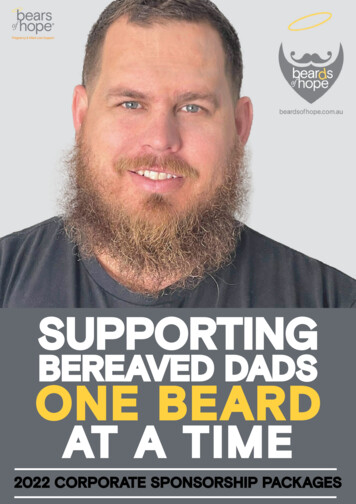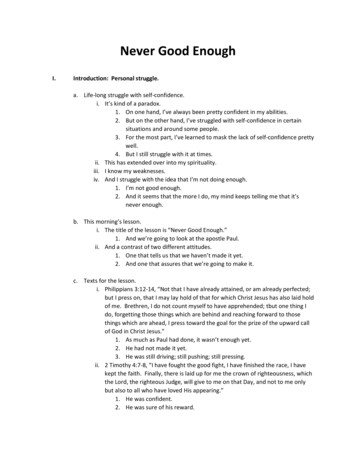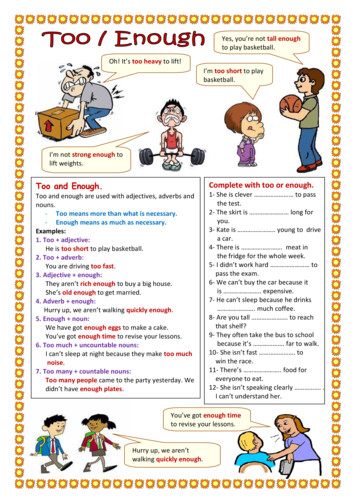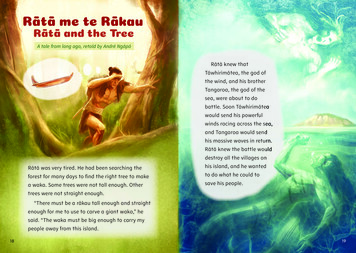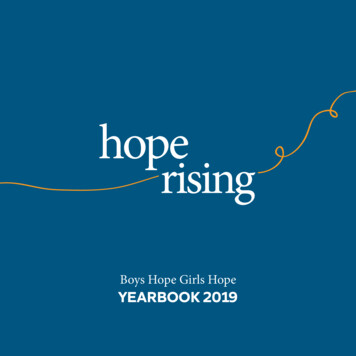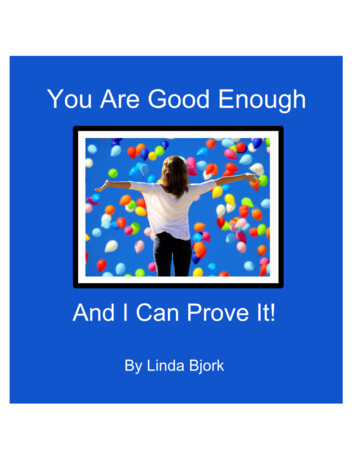
Transcription
You Are Good EnoughAnd I Can Prove It!A message of hopeBy Linda BjorkCopyright 2019 all rights reservedAll images open source or owned by the author
Have you ever wondered if you’re good enough? Well I have theanswer to that question. The answer is yes and I can prove it.You are good enough,and I can prove it!You are good enough,and I can prove it!You are good enough,and I can prove it!You are good enough,and I can prove it!
Am I good enough?Have you ever wondered if you’re good enough? Well, I have the answerto that question. The answer is yes and I can prove it.We’re going to use conditional logic for this proof. Conditional logic allowsyou to automatically make a decision about whether or not something istrue, based on whether or not certain conditions, or criteria, are met. If theconditions or criteria are met, then we know that something is true; but ifthe conditions are not met, then we know that thing is not true.Conditional logic is usually written in an “if, then” statement like this:
Let’s use an example. How can I prove that an animal is a bird?First we need to start by defining what a bird is. What makes a bird, a bird?Well they have wings; that is an excellent start. All birds have wings.But it’s not enough criteria to prove that something is a bird, because batsalso have wings, bees have wings, and butterflies have wings.
Just because a creature has wings, is not enough to prove that it is a bird.We need a more complete list of criteria, to make certain that if all theseconditions are met, then we know that we have a bird, and nothing besidesa bird.So what else do birds have? They have feathers, they have beaks, theyhave hollow bones, they’re warm blooded, they have a spine, and they layeggs.If an animal meets all of these criteria, then we can prove that it’s a bird
To test our theory, let’s try a couple examples. A bat has wings, a spine,and it’s warm blooded; but it doesn’t have feathers or a beak, and it doesn’tlay eggs. So we can prove that it’s not a bird.
A turtle has a spine, a beak, and lays eggs; but it’s cold blooded, anddoesn’t have wings, feathers, or hollow bones.It doesn’t meet all the conditions, so it’s not a bird.The next animal I’m thinking about has wings, feathers, a beak, hollowbones, lays eggs, and is warm blooded.
It meets all the conditions or criteria; therefore, it is a bird.So you can see how conditional logic works. In order to determine ifsomething is true, you verify that it meets all the necessary conditions orcriteria. But in order to be able to use this tool, we have to clarify a fewthings. First of all, we need to know what it is we want to prove, and thenwe need to know what conditions, or criteria, need to apply.Good enough for what?Now, right away, we have some difficulties in proving the statement, “I amgood enough,” because it isn’t very specific. Good enough for what?
What does “good enough” really mean?Most people don’t really know how to define what they mean; it’s just afeeling that they want to be enough. That lack of specificity makes itchallenging to come up with a list of criteria that we’re supposed to meet;so I’m going to clarify some things that I think it means when we wonder,“Am I good enough?” I think it means, “Am I good enough to be loved,valued and appreciated? Am I good enough to be accepted, and to beacceptable? Am I worthy to live on this planet, and to breathe the air that Ibreathe?” So, using those assumptions, I’m going to define “good enough”as being worthy of love and belonging.Definition: Good enough worthy of love and belonging
Worthiness is having worth or value. Something that is valuable has worth.So in order to prove that we’re worthy of love and belonging, we have toprove that we have value. That is the condition that needs to be met. It wehave value, then we are worthy of love and belonging.The next step presents an additional challenge. We need to prove that wehave value, but how? What set of criteria needs to be met, so that we canprove, without a doubt, that we have value?
How do we determine our value and worth?People try a lot of different things to prove that they have value. Is myvalue determined by how many friends I have on my Facebook page? Is ithow many “likes” I get on my latest selfie? Maybe it’s based on how manypeople share my latest post, or retweet my latest tweet?Is it how smart I am? Or is it how talented I am, or how beautiful I am?Perhaps it is how popular I am, or how successful I am?Maybe it is what kind of car that I drive, or the size of the house that I livein. Or it could be based on what clothes I wear, or how thin I am, or howrich I am. Perhaps it’s based on how busy I am, and the length of my “todo” list.Possibly it’s based on whether or not I’m in a relationship, or I’ve metsomeone else’s approval (like my parents’ approval, my boss’ approval, myboyfriend’s approval, my neighbor’s approval, the cool kids’ approval, andso on).Maybe it’s comparative, and I just need to show that I’m the same aseverybody else. Or perhaps I just need to show that I’m better thansomebody else. What criteria goes on this list? What set of conditionswork?
That list simply doesn’t workPart of the problem is that people have tried all of these things, and theydon’t seem to satisfy the equation. We have lots of examples of peoplewho have all of these things, but still don’t feel like they’re good enough. Ifpeople who are rich, beautiful, and popular still don’t feel like they’re goodenough, then what more do we have to do?This list of criteria seems hard enough; what more do you want from me?What do I have to do in order to be good enough?Looking to the past to find answers for todayTo get some help for this dilemma, we’re going to look in the past, becausethis is not the first time in history that we’ve had a quandary like this tosolve. In the 1600’s, in the time that could be considered the pre-dawn of“The Enlightenment,” philosophers had another difficult problem to solve.They wanted to know how to be able to prove that we exist.They wanted to be able to prove that we’re not just in some sort of “Matrix”situation, where we think that we exist, but maybe we really don’t. What if
life is really just a dream? What sort of criteria counts to prove that wereally exist? What do we put in the “conditions” box?A baffling dilemmaPhilosophers were baffled by this dilemma. At first they thought maybethey could use the senses to prove that we exist. We can see, hear, touch,taste, and smell; surely that must prove that we exist. However, theyended up rejecting the senses as evidence because how do we know thatwe don’t just think that we are seeing, hearing, touching, tasting, andsmelling? How do we prove that we’re not just dreaming the whole thingup? One French mathematician and philosopher, named Rene Descartes,contemplated about this dilemma a lot.
He pondered about these questions. How can I prove that I exist? Howcan I prove that I don’t just think that I exist? Then he had an epiphany. Herealized that the answer was actually hidden inside of the question.
He realized that he can prove that he exists, because he was thinkingabout proving that he exists. He said, “I exist because I think,” or in otherwords, “I think, therefore I am.”And recognizing that simple truth made all the difference. The conditions inthe “if, then” box, weren’t actually a long, complicated list of criteria, it was asimple given truth, “I think, therefore, I am.”How does that apply to today?So here we are today, pondering on the question, “Am I good enough?”And in order to prove that we’re good enough, we need to prove that wehave value and worth. So how can we prove that we have value? Whatset of criteria satisfies the equation? That’s a question that I’ve ponderedabout a great deal.
And just like the case where Descartes was trying to prove the impossiblequestion of, “How do I know that I don’t just think I exist?” and found thatthe answer was actually hidden inside of the question, the same thing istrue here. In the case for the question, “How can I prove that I havevalue?” the answer is actually already hidden inside of the question. It’snot, “Do I have value?” It is actually, “I do have value.” It is a simple, givenfact that all human souls have inherent value. It is our birthright. We havevalue simply because we exist.We’re ready to complete the proofSo now we have enough information to prove logically that I am goodenough, and that you are good enough. And we’re going to do it in acouple steps.
The first step was already proved to us by Rene Descartes; he concludedthat I think, therefore I am.Then, given the fact that all human souls have intrinsic, inherent value; wecan prove that, I am, therefore I have value.
Then, we can prove that because I have value, then I am worthy of loveand belonging.Then, by definition, we can prove that because I am worthy of love andbelonging, therefore, I am good enough. You are good enough. You aregood enough right now, as you are.
A second enlightenmentIt is time for a second “enlightenment.” It is time to recognize the truth thatall human souls have value, and are worthy of love and belonging. It istime to recognize and accept the fact that you are already good enough,and not worry about it anymore. It is time to move forward.What is the next step in the equation? That is entirely up to you. Thepossibilities are endless.
Therefore, in conclusion, we have logically proved that you are goodenough, and have amazing potential.So if you’ve ever asked yourself the question, “Am I good enough?”The answer is yes, and you can prove it.
The value of a human soulHow is self-worth determined? Many of us use external factors like: wealth,status, accomplishments, popularity, or other people’s opinions to arelovable/likable. However, the truth is that the value of a human soul isintrinsic. Intrinsic means “belonging to a thing by its very nature.” It comesfrom the Latin word intrinsecus which means interior or inner.Somesynonyms for intrinsic include: inherent, innate, inborn, natural, built-in,inseparable, permanent, indelible, ineradicable, integral, and fundamental.Let me repeat, the value of a human soul is intrinsic; it comes from theinside.You have infinite worth simply because you exist.It is yourbirthright. It doesn’t need to be earned or verified, and it is completelyindependent of any external factors. Deep down inside, you know thatalready.There are a few moments in the lifespan of a person that we reflexivelyrespond to that knowledge. One is when a baby is born. The love thatparents feel for their infant child is beyond their ability to express. Does thatbaby have value and worth? Oh yes! Is that baby lovable/likable? Ohyes! What did the baby do to earn that worth and that lovability? Absolutelynothing. They possess those qualities simply by existing. Do those qualitiesof worth and lovability diminish over time? No.Another moment in time where we are reminded of the intrinsic value of ahuman soul, is when a life is taken, and we mourn the loss of someone we
care about. Each life has intrinsic value. Our worth and value are inborn,natural, built-in, inseparable, and permanent.What we believe matters more than what is trueWe have intrinsic value, that’s a fact, but just because something is truedoesn’t mean we believe it. Even though we have inherent worth andlovability as our birthright, we may have been told so many times by others,or even by ourselves, that we’re worthless, or that we have to do somethingto earn and prove our value and lovability that we believe it. And in this case,what we believe is more important than what is actually true.Researcher Brene Brown came to a similar conclusion after her six-yearstudy on what causes shame. She wanted to know why some people enjoylove and belonging while others are always wondering if they’re goodenough. She found that it all comes down to one single variable: a person’sbelief of whether or not they’re worthy.
How do I learn to love and accept myself?Truth is truth whether or not you believe it. We have logically proved thatyou are good enough, and have amazing potential; but that doesn’tnecessarily mean that you believe it. If you already believe that you’regood enough, and that you’re worthy of love and belonging, that’sawesome; but if you don’t, then let’s do something about it. I’ll share threetools to help you begin to believe in your own intrinsic, inherent value andworth: repetition, journaling, and an “I am” poster.The power of repetitionOne way to begin to believe the truth that you have value, and are worthy oflove and belonging is through the power of repetition. We can create positivestatements about ourselves, and repeat them over and over, to create a new,healthier, positive belief system.Research shows that if you hear something enough times you begin tobelieve it. We are more likely to believe things that we hear over and overagain, just because we heard it over and over again, and it doesn’t matter ifit’s true or not. We believe things because they are familiar. Scientists callthis phenomenon the “mere exposure effect” and it’s baffling because it hasnothing to do with truth, reason, or logic. This is one reason why it’s sodangerous to have circulating thoughts and statements like, “I’m not goodenough,” or, “I don’t fit in.” If you repeat those thoughts and those statementsoften enough, you begin to believe them, even when they’re nottrue. Furthermore, a child who has been told over and over again that theycan’t do something, or that they’re stupid, or worthless, or not safe, or notgood enough, will accept these familiar sayings as true.
The flip side of the coin is that once we believe something, whether or not itis true, our subconscious will fight to protect those beliefs by rejectinganything that is unfamiliar or contradicts what we already believe. Sadly,that means that the child who has grown up with the belief that they’re stupid,or worthless, or not safe, or not good enough, will then fight to defend andsupport those beliefs their whole life. That is, unless they go through theconscious effort to change those beliefs.When thoughts and feelings are repeated over and over, they becomefamiliar, and we believe them to be the only possible truth. It may seemironic, but a person may subconsciously believe that feelings ofworthlessness, unworthiness, invisibility, or rejection, are more “safe” thanfeelings of being loved, valued, accepted, and appreciated, because thosethoughts and feelings are unfamiliar, and therefore “dangerous.” Peopleoften subconsciously fight to hold onto those hurtful thoughts andbeliefs.They reject thoughts about happiness, positivity, hopefulness,confidence, worthiness, success, or peace, because they contradict whattheir minds already believe to be true.The mere exposure effect, makes it difficult to feel confident and worthy whenyou’re stuck in a pattern of feeling worthless and unlovable. However, thereis a difference between difficult and impossible.If a thought keeps running through your mind like, “I’m not good enough,”replace it with another opposite and positive statement such as, “I amworthy and deserving of being loved, valued and appreciated. I am loved,
valued and appreciated. I am good enough.” And repeat that over andover again. There’s a lot of truth taught in the children’s book “The LittleEngine That Could” by Watty Piper. Repeating, “I think I can, I think I can,”(or whatever positive mantra is applicable) really makes a difference.It won’t be easy however. When you say those things your subconsciousmay tell you that they’re lies. Studies show that once we believe something,we instinctively defend and protect it without even being aware of it. But ifwe keep at it relentlessly and consistently, that power of repetition can retrainour brains to accept those things as true.Journaling to increase awarenessOne way to increase awareness about your perception of your lovability andself-worth is by looking deeper at your core values and beliefs. Spend 2030 minutes writing on one or more of the following prompts: I have inherent value and lovability because I believe I only have worth and value if I believe I am only lovable if My beliefs about my value and lovability came from
“I am” posterHere’s another tool to help you begin to believe the truth of your own inherentvalue, it’s called an “I am” poster. The “I am” poster helps reawaken the truththat our value is intrinsic. Our true value comes from the inside, rather thanfrom external sources like appearance, wealth, or popularity.Spend two minutes each morning and again each evening looking at, andpondering about, the “I am” poster included in this book, while listening toinspiring instrumental music. The visual images and words combined in the“I am” poster engages both hemispheres of the brain, and facilitatesimprovements in reprogramming our patterns of thinking.Addingbackground music takes it to a whole new level.Choose background music like the orchestral film music played in thebackground of your favorite movie. This music is commonly known as “epicmusic.” Just do a quick search on YouTube and you’ll have numerousplaylist choices available in an instant.The soothing power of music is well established. Different kinds of musiccan produce different kinds of emotions, and we can use that to ouradvantage as well. Some music lets you know that the hero is about to dosomething brave and amazing; and other music lets you know thateverything is peaceful, and going to turn out okay. Either of these might bejust what you need. Perhaps you need a boost of confidence and power, orperhaps you’re in the need of a calming reassurance that these new ideasare safe, and that everything is going to be okay.
About the authorHi, my name is Linda Bjork. I am an author, andthe founder and executive director of Hope forHealing, a non-profit charity.I spent the majority of my life believing that I was unworthy and undeservingof love. I knew that there was love in the world, but I thought it was for thosewho were worthy of that love, and I simply wasn’t one of those lucky enoughto have fate smile upon them.Why did I believe this? Mostly it was because of events in my early yearsthat I interpreted and misinterpreted. I was six years old when I made theconclusion that I wasn’t worthy and deserving of love, and that belief systemwould remain with me, and define my world, for the next forty years.How did this belief system affect me? My self-esteem was basically at zero.It’s interesting that after deciding that I wasn’t good enough, no amount ofsuccess or accomplishment could convince my mind that I was enough. Thedecision had already been made. Period. It didn’t matter that I performed atDisneyland with my choir, or performed onstage in dance performances andin musicals. It didn’t matter when I received trophies for debate competitions.It didn’t matter that I graduated at the top of my class, and spoke atgraduation. It didn’t matter that I received a four-year full tuition scholarship.It didn’t matter when I graduated college with honors. It didn’t matter when Iserved in community and church leadership positions. It didn’t matter that I
had a wonderful husband, and raised a beautiful family. It didn’t matter whatI did, because I already had decided that I wasn’t good enough when I wassix years old, and that belief system remained solidly in place. I wasn’tconsciously aware of what I was doing, but those underlying beliefs ruled myworld.Later, I sought help from a mentor who helped me uncover the reasons whyI felt the way that I did. We found the source, and I realized that my reasonsfor deciding that I was unworthy and undeserving of love were not valid.However, just knowing the truth wasn’t enough to change a lifetime of habitsand beliefs. I was like a recovering addict who wanted to keep going backto what was familiar. It seems so strange to want to go back, but there is afeeling of safety in familiarity. The unknown can be scary, but now that I’mbreaking free from a lifetime of addiction to unhealthy and untrue beliefs, mylife is so much better.I know there are others out there who, like me, have been tied down to falsebeliefs for one reason or another, and I know they would be so much happier,feel more fulfilled, and enjoy so much more peace and abundance if theyonly understood the truth. I invite you to believe and to share this messageof hope: You are good enough!
Hope for HealingIf you’d like more tools to help increase confidence, happiness, and peace inyour life, please visit the Hope for Healing website.Hope for Healing offers tools, information, resources, and a plan to increasehappiness, build confidence and self-esteem, strengthen families andmarriages, manage stress, and help alleviate symptoms of depression andanxiety. You have more power than you might think.Join with us!www.hopeforhealingfoundation.org
Other books by Linda BjorkCrushed: A Journey Through DepressionAn inspiring true story of triumph over despair so relatableand unflinchingly honest that you’ll wonder if you’re readingyour own story and will start believing in your own happyending. This captivating narrative empowers the readerwith tools to revive hope and facilitate healing.(Available on Amazon)Praise for Crushed:I couldn't put it down!I loved how the author showed greatness through trial andtribulation, and how real and raw her emotions were throughout the book. I laughed, Icried, and I celebrated as she conquered life throughout her journey! This book was lifechanging, deepening my vision as to how we can truly learn and become better fromothers experiences! Everyone who reads it will find some way that they can relate to theauthors experiences and at the same time gain insight as to how to cope with thestruggles of life! Such an amazing read! One that I will read over and over again!!!-Misty C.A very personal honest and insightful journey of self-reflection and emotional healing. Weare all broken to some degree and need to be aware of some of the tools we have to findhealing and mending the things that create a false and negative self-image. Linda hasopened herself up in a very vulnerable way to allow you on that journey of healing in thehopes that you may find something of value in there to help with your healing. I did, andI hope you will as well. – Troy J.
I couldn't put this book down. Linda is so real, so honest, and made it easy for me toidentity things in my own life that I needed to process and let go of. She clearly explainsher entire journey, from a lifetime of being depressed and suicidal to finding contentmentand self-love. Great book! – Jane D.Heartbreakingly resonant for every invisible woman. A beautifully written display of howgenerational pain can lead to generational healing. – Sherrie C.Bjork takes readers through some very personal and real struggles and points them tothe light at the end of the dark tunnel of depression. She provides readers with resourcesthat allow them to emerge from that tunnel and embrace new levels of happiness. –Debbie E.It's a great read! I hooked from the start and read it in one sitting! I am so happy Lindachose to share her personal journey from such inner turmoil to finding hope and joy in lifeonce more! It makes me wonder how many others may have similar false beliefs aboutthemselves that are holding them back from the joy this life is meant to be. How gratefulI am that she was courageous enough to face her struggles and challenge them! She isso open and descriptive of the healing process she took that anyone can benefit from herstory. – Lindsay S.Linda is an amazing writer and has done a superb job with this book of self-explorationand mastery over a difficult and debilitating subject. Great and satisfying read. – MarieI had a hard time putting it down. This book caused me to think differently about others,and the secret pain that so many carry. But, by far the greater portion of this book isabout the process of healing that took the author from crushed to truly recovering, and inthe process healing many of her relationships as well. My favorite thing about this bookis the detail it gives of the various tools she learned for recovery. It has caused me tothink differently in ways that are affecting my own inner happiness. There are manypeople I know who I hope will read this book and be blessed by it. – David C.
You Got This!An action plan to calm fear, anxiety, worry, and stressYou Got This! is a thoroughly researched, easy-to-read,well-designed action plan to calm feelings of fear, anxiety,worry, and stress with a wide variety of proven cognitivebehavioral therapy techniques, tips, and tricks thatempower people to regain a sense of peace and control intheir lives.You Got This! will show you how to decrease stressors,increase coping skills, increase confidence, increaseresilience, and find solutions to your problems.Praise for You Got This!“Organized, well-researched, and filled with easy-to-read personal stories and examples,You Got This! is a great resource if you’re feeling overwhelmed.”-Leslie Householder, Best-selling author of The Jackrabbit Factor“If you’re serious about taking control of your life and coping with anxiety and stress, thisbook is for you.”-Official Review, Reedsy“You Got This! deserves the maximum rating of 4 out of 4 stars, as it is practical, concise,and well-executed. Honestly, I have not read a self-help book that has impacted my lifelike this in a while.”-Official Review, OnlineBookClub.org
“Loved it! An impressively-researched self-help guide with a 30-day plan to reduceanxiety and cope with stress, written in simple language.”-Satabdi Mukherjee“You Got This!: An Action Plan To Calm Worry, Fear, Anxiety, And Stress provides selfhelp readers with a concrete course of action based on cognitive behavioral therapytechniques to reduce stress and anxiety—and in these times, it’s a much-neededapproach.”-Senior Reviewer, Midwest Book Reviews“Thank you for the opportunity to look at your fine title! I was pleased to read your excellentbook and I’m delighted to recommend it to others.”-Diane Donovan, Donovan's Literary Service*Pathway to Happiness: A Wellness Toolkit“Pathway to Happiness” is a guide book with a flexibleoutline where you create your own wellness goals andchoose from a wide selection of wellness tools to suityour particular needs. It is a simple step-by-step actionplan to awaken the answers that are already inside ofyou.I invite you to join with me in making the world a better place by working on the onlyperson you truly have the power to change yourself.*This book is available to download for free on the Hope for Healing website.
*30 Days to a Better MarriageHealthy marriages lead to healthy lives, healthy families,and a healthy community. Marriage matters.A perfect marriage is not about finding a perfect person;it’s more like two imperfect people who refuse to give upon each other.*This book is available to download for free on the Hope for Healing website.*30 Days to Alleviate DepressionIf you’re struggling with depression, this might be themissing key you’re looking for. Keep your doctor.Continue taking your medication. Add this.Some experts believe that depression is caused by afeeling that people are unable to solve their problems.“30 Days to Alleviate Depression” is a comprehensiveaction plan designed to help empower people to regain a sense of peace and control intheir lives by following a set of simple, consistent action steps. Easy, step by stepcoaching guides you through each day explaining not only what to do, but why it works.Following this 30-day course is an excellent companion to professional treatment andmedication to help with relieving symptoms of depression, boosting mood, regainingconfidence and improving control over your life.
There is hope for healing from depression and other mental and emotional issues. Thereis a way to change and upgrade the way we think and the way we feel. Are you ready tochoose happiness?Praise for 30 Days to Alleviate Depression“Linda has been down the path of depression and successfully pulled herself out with thehelp of simple tools that really work. A great book for those wanting a happier, morehopeful life.”-Suzanne Lindsay, Mentor, Life Coach and owner of Life Unblocked“My heart and mind were touched by Linda’s work. I like the clearness and simplicity ofher writing.She has experienced first-hand what she presents and teaches.Herprinciples are organized into a step-by-step guidebook that have helped me in learninghow to cope and grow. She has researched and presents verified information about whyit worked. My experience in reading and studying these ideas has been uplifting andhelped me move forward. I highly recommend it!”-M. Grover, Review on Amazon*This book is available to download for free on the Hope for Healing website
Have you ever wondered if you're good enough? Well I have the answer to that question. The answer is yes and I can prove it. You are good enough, and I can prove it! . Definition: Good enough worthy of love and belonging. Worthiness is having worth or value. Something that is valuable has worth.
